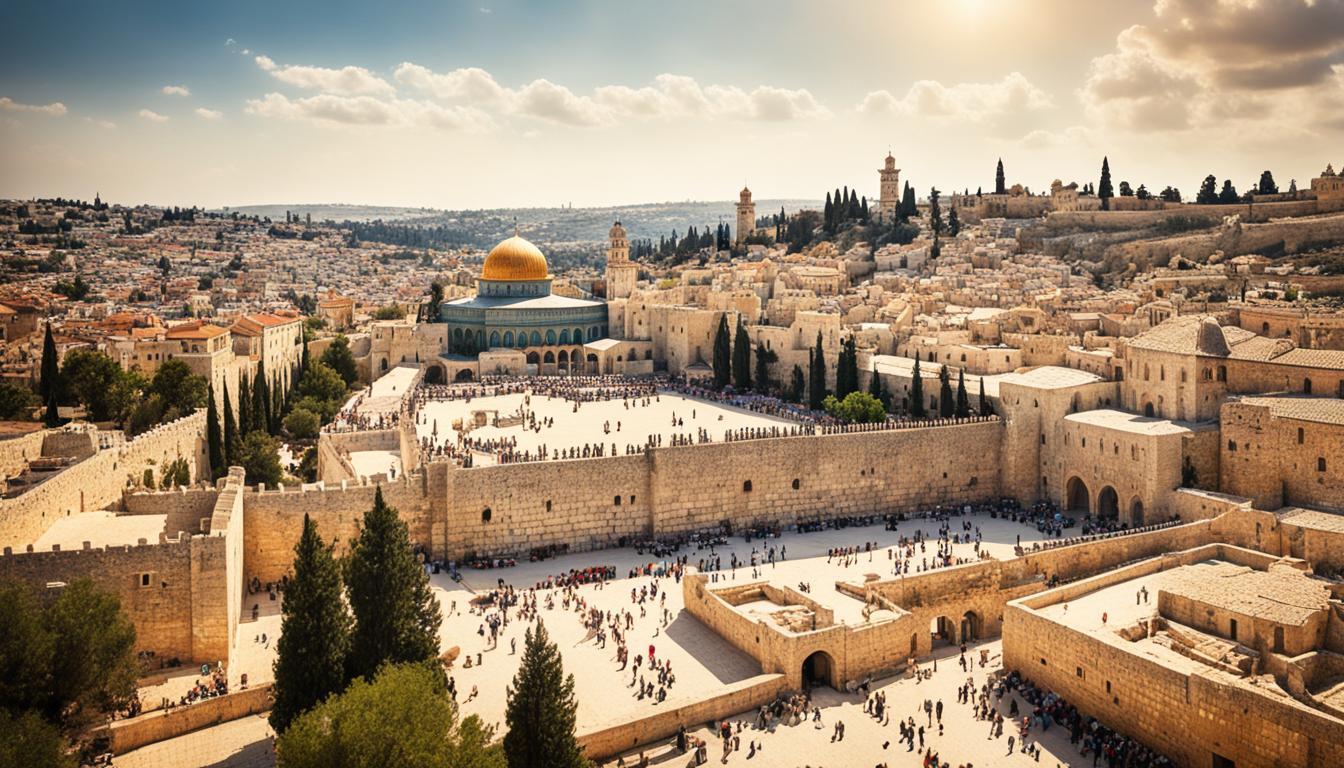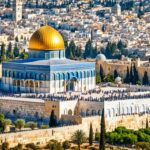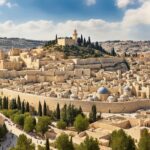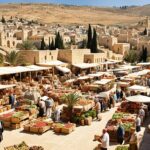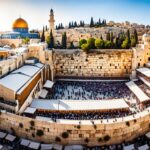Jerusalem, a city steeped in biblical history, holds significant importance in the pages of the Holy Bible. It is a place that resonates with the hearts and minds of Jews, Christians, and Muslims alike. Throughout the Bible, Jerusalem is mentioned numerous times, showcasing its deep religious significance and its enduring impact on faith and history.
Key Takeaways:
- Jerusalem is a city of immense biblical significance and holds a special place in the beliefs of Jews, Christians, and Muslims.
- The city was the capital of the Jewish kingdom under King David and the location of Solomon’s Temple, making it a focal point of worship.
- Jerusalem’s biblical history encompasses the stories of Abraham, Joshua, and the life and ministry of Jesus.
- The conflicts and disputes over Jerusalem’s control continue to be major points of contention in the Israeli-Palestinian conflict.
- Exploring Jerusalem’s biblical history allows us to understand its profound impact on faith, culture, and history.
The Origins of Jerusalem
Jerusalem’s origins date back to ancient times, with the city mentioned in various religious texts. It holds a significant place in biblical history with its deep connections to ancient Jerusalem as depicted in the Bible. The Holy Bible mentions Jerusalem multiple times, emphasizing its religious and historical importance.
The ancient settlement of Jerusalem began on the eastern ridge, near the Gihon Spring, which served as a vital water source. Over time, Jerusalem expanded northward during the reigns of David and Solomon, becoming a prominent city in the biblical narrative.
“And Melchizedek king of Salem brought out bread and wine. (He was priest of God Most High.) And he blessed him and said, ‘Blessed be Abram by God Most High, Possessor of heaven and earth; and blessed be God Most High, who has delivered your enemies into your hand!’ And Abram gave him a tenth of everything.” – Genesis 14:18-20 (ESV)
The Bible recounts significant events that took place in Jerusalem, such as the meeting of Melchizedek and Abraham. Jerusalem also witnessed the conquest led by Joshua, where the city was captured and established as a key stronghold.
| Biblical References | Significance |
|---|---|
| Genesis 14:18-20 | Meeting of Melchizedek and Abraham in Salem (later Jerusalem) |
| Joshua 10:23-26 | The conquest of Jerusalem by Joshua |
The ancient references to Jerusalem in the Bible provide insight into the city’s historical and religious significance. These narratives lay the foundation for understanding the importance of Jerusalem throughout history and its enduring role in the hearts and minds of believers.
Ancient Jerusalem in the Bible:
The Biblical accounts of Jerusalem’s origins and early history offer a glimpse into the city’s significance and its role in shaping the religious and cultural landscape of the time. As we delve deeper into the biblical narrative, we discover a tapestry of historical events, spiritual encounters, and profound human experiences that shed light on the enduring legacy of ancient Jerusalem.
Jerusalem in the Time of David and Solomon
During the reign of King David, Jerusalem became the capital of the Jewish kingdom. After capturing the city, David established it as the central worship center for all Israel. The Ark of the Covenant was brought to Jerusalem, solidifying its significance as a religious and political hub. David’s son, Solomon, later built the first temple in Jerusalem, further cementing its importance as a symbol of the Jewish faith and a destination for pilgrims.

The temple became a place for believers to seek spiritual connection and guidance. Its grandeur and splendor reflected the magnificence of the Jewish religion. Jerusalem, with the temple at its heart, held a special place in the hearts and minds of the faithful. The city served as a beacon of hope and a testament to the deep connection between God and His people.
Jerusalem during the Babylonian Exile
In 586 BC, Jerusalem faced a devastating fate during the Babylonian conquest. The city and its magnificent temple were mercilessly destroyed, and the people of Judah endured the anguish of captivity in Babylon. This dark period in Jerusalem’s history marked a time of great suffering and loss for the Jewish community.
Decades later, however, a glimmer of hope emerged as the Persians, under the leadership of King Cyrus, allowed the Jews to return to Jerusalem and rebuild their beloved temple. This marked a remarkable period of renewal and restoration for the city, bringing back its religious significance and providing the Jewish people with a renewed sense of identity and purpose.
“So the elders of the Jews built and prospered, through the prophesying of Haggai the prophet and Zechariah the son of Iddo. And they built and finished it, according to the commandment of the God of Israel…”
Under the guidance of prophets like Haggai and Zechariah, the people labored diligently to rebuild the temple and restore its former glory. Their perseverance and faithfulness to God’s commandment played a crucial role in the revival of Jerusalem as a sacred and cherished center of worship.
This period of rebuilding and restoration in Jerusalem laid the foundation for its future as a spiritual and cultural hub. It strengthened the Jewish community’s connection to their history, tradition, and faith, shaping the city’s destiny for generations to come.
Reconstruction of the Temple
The reconstruction of the temple in Jerusalem was a monumental undertaking, requiring careful planning and collaboration among the returning exiles. The restored temple, often referred to as the Second Temple, embraced the architectural grandeur of its predecessor.
Here is a table showcasing the key aspects of the temple reconstruction:
| Aspect | Description |
|---|---|
| Building Material | Stones, cedar beams, and other quality materials |
| Artistic Design | Ornate decorations, intricate carvings, and exquisite craftsmanship |
| Dimensions | Approximately 45 meters tall and 90 meters long |
| Inner Sanctum | The Holy of Holies, housing the Ark of the Covenant |
| Worship Practices | Offerings, sacrifices, and observance of religious festivals |
| Importance | Central place of worship for the Jewish community, symbolizing their relationship with God |
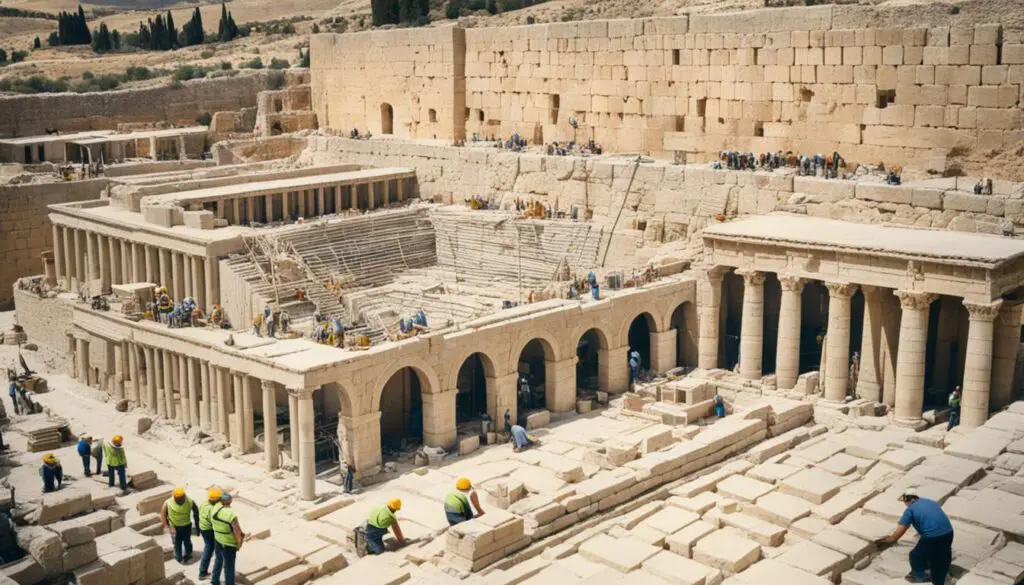
The reconstructed temple served as a powerful symbol of spiritual revival and national identity for the Jewish people. It became a focal point for worship, celebration, and the cultivation of their relationship with God.
The temple’s restoration was an immense triumph for the people of Judah, breathing new life into Jerusalem and revitalizing its spiritual significance. It laid the groundwork for Jerusalem to reclaim its standing as a holy and revered city, forever etching its place in the rich tapestry of biblical history.
Jerusalem under Roman Rule
After the Roman conquest of Jerusalem in 63 BC, the city became part of the Roman province of Judea. This marked a significant shift in power and administration, as the Romans imposed their rule over Jerusalem and its inhabitants.
During this time, the Second Temple, a sacred place of worship for the Jewish people, stood at the heart of Jerusalem. However, in 70 AD, the Romans destroyed the temple, leaving only the Western Wall standing as a poignant symbol of the Jewish faith and a place of prayer and devotion.
“The destruction of the Second Temple was a devastating blow to the Jewish people, but the Western Wall became a tangible reminder of their resilience and unwavering connection to Jerusalem.”
Herod the Great, a Roman-appointed king of Judea, played a significant role in the construction and expansion of the Temple Mount, the religious complex that housed the Second Temple. Under his rule, the Temple Mount saw remarkable renovations and additions, including the iconic Dome of the Rock.
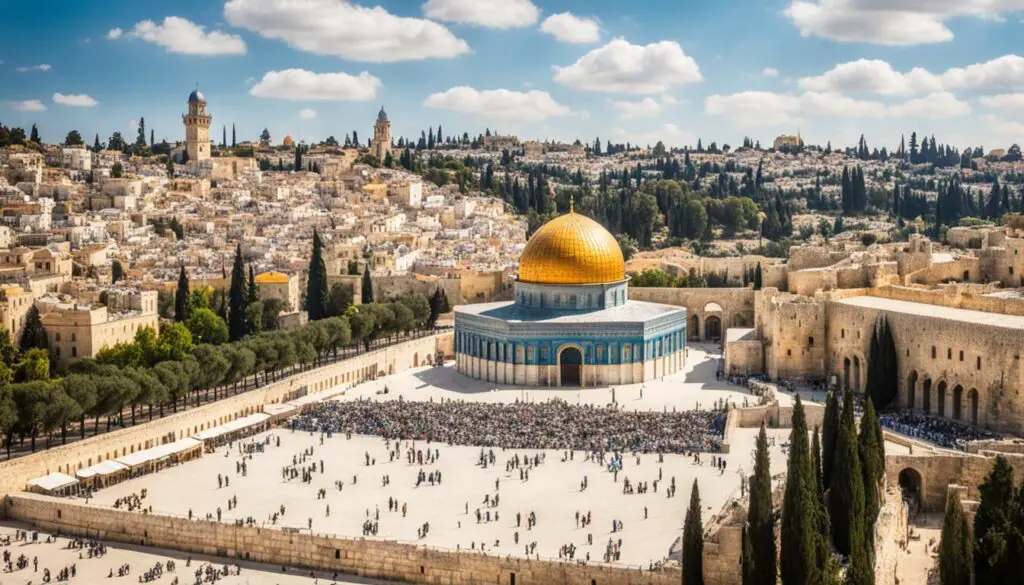
Key points:
- Roman conquest of Jerusalem: The Romans took control of Jerusalem in 63 BC, making it part of the Roman province of Judea.
- The destruction of the Second Temple: The Romans destroyed the Second Temple in 70 AD, leaving only the Western Wall remaining.
- Herod the Great: Herod the Great, a Roman-appointed king, made significant renovations and expansions to the Temple Mount.
- Temple Mount: The Temple Mount is a sacred religious site that became an important symbol for both Jewish and Roman cultures.
- Western Wall: The Western Wall, standing as the last remnant of the Second Temple, became a place of devotion and prayer for the Jewish people.
Jerusalem in the Time of Jesus
Jerusalem holds a central place in the life and ministry of Jesus, making it a significant destination for Christians around the world. It was in Jerusalem that Jesus experienced some of the most pivotal moments of his life, including his crucifixion and resurrection. The city’s deep connection to Jesus has made it a sacred and revered place for believers.
One of the most important sites in Jerusalem for Christians is the Church of the Holy Sepulchre. This historic church is built on the traditional site of Jesus’ crucifixion and burial, according to Christian tradition. It attracts pilgrims from all over the globe who come to pay homage to the place where Jesus suffered and died for their sins.

For Christians, the crucifixion of Jesus represents the ultimate act of love and sacrifice. It is a profound moment that signifies redemption and salvation. Visiting the Church of the Holy Sepulchre allows believers to walk in the footsteps of Jesus and experience the sacredness of the place where he gave his life.
“For God so loved the world that he gave his one and only Son, that whoever believes in him shall not perish but have eternal life.” – John 3:16 (NIV)
Beyond the crucifixion, Jerusalem is also associated with the resurrection of Jesus. According to the Gospels, Jesus rose from the dead three days after his crucifixion. This event is celebrated as the pinnacle of hope and victory over death. The resurrection of Jesus affirms the Christian belief in eternal life and offers comfort to believers.
As Christians reflect on the life, crucifixion, and resurrection of Jesus, Jerusalem serves as a powerful reminder of the profound love and sacrifice demonstrated by Jesus. It is a place where believers can deepen their faith and draw inspiration from the events that unfolded in this ancient city thousands of years ago.
Jerusalem through the Ages
Throughout history, Jerusalem has witnessed the rise and fall of various empires and has been under the control of different dynasties. Two significant periods of foreign rule in Jerusalem were the Ottoman Empire and the British control.
The Ottoman Empire had a significant influence on Jerusalem from the 16th century until the end of World War I. Under Ottoman rule, Jerusalem flourished as an important center of trade and culture. The empire’s control over Jerusalem lasted for over four centuries, leaving a lasting impact on the city’s architecture, culture, and governance.
Following the decline of the Ottoman Empire, Jerusalem came under British control after World War I. The British administered the city under the League of Nations’ mandate until 1948. During this time, the British implemented various reforms and modernizations in Jerusalem, shaping the city’s urban planning and infrastructure. However, the contentious issue of British control over Jerusalem eventually fueled tensions and conflicts between Jewish and Arab communities.
The Israeli-Palestinian conflict, which emerged in the mid-20th century, highlighted Jerusalem as a major point of contention. Both Israelis and Palestinians claimed Jerusalem as their capital, leading to ongoing disputes and hostilities. The city’s religious significance to Jews, Christians, and Muslims further intensified the conflict, making it a complex and deeply rooted issue.
The Israeli-Palestinian Conflict Over Jerusalem
The Israeli-Palestinian conflict over Jerusalem stems from competing national and religious aspirations. Both Israelis and Palestinians consider Jerusalem as their rightful capital, leading to clashes and political struggles. The status of Jerusalem, particularly the control and division of the Temple Mount, has been a major stumbling block to peace negotiations between the two sides.
Despite numerous diplomatic efforts and negotiations, a lasting resolution to the Israeli-Palestinian conflict remains elusive. The status of Jerusalem continues to be a contentious issue, and its future remains a focal point in the pursuit of a comprehensive peace agreement.

The Temple Mount
The Temple Mount holds immense religious significance in Jerusalem. It is regarded as the holiest site in Judaism and the third holiest in Islam. The complex is home to several prominent religious structures, including the Western Wall, the Dome of the Rock, and the Al-Aqsa Mosque.
The Western Wall, also known as the Wailing Wall, is a remnant of the Second Temple and is considered the holiest place where Jews can pray. It serves as a symbol of Jewish faith, attracting visitors from around the world to offer prayers and leave notes in the crevices of the ancient stones.
The Dome of the Rock is an iconic Islamic shrine located on the Temple Mount. It is recognized for its stunning architectural design and significant historical and religious importance in Islam. The golden dome sits atop the rock from which Muslims believe the Prophet Muhammad ascended to heaven.
In close proximity to the Dome of the Rock, the Al-Aqsa Mosque stands as one of the oldest mosques in the world. It holds a critical place in Islamic history and is revered as the third holiest site in Islam after Mecca and Medina.
The control and access to the Temple Mount have been a source of contention and conflict for centuries, as both Jews and Muslims place immense importance on this sacred space. The complexities surrounding the Temple Mount remain a central issue in the Israeli-Palestinian conflict and present ongoing challenges in finding a peaceful resolution.
The Western Wall
The Western Wall, also known as the Wailing Wall, is a symbol of spiritual resilience and a sacred site for Jewish prayer. It is a remnant of the second Jewish temple in Jerusalem, which was destroyed by the Romans in 70 AD. The Western Wall holds immense significance for the Jewish people, serving as a tangible connection to their history, faith, and identity.
Located in the Old City of Jerusalem, the Western Wall is a place of pilgrimage and devotion for Jews from around the world. Many visitors come to offer prayers, express gratitude, and seek comfort in the presence of this ancient wall. The Western Wall Plaza, where the wall is situated, is a bustling hub of religious activity and communal worship.
As a symbol of Jewish resilience and determination, the Western Wall bears witness to centuries of history, including times of triumph and tragedy. It is a tangible link to the Jewish past and a powerful testament to the enduring strength of the Jewish people.
“The Western Wall is a reminder of our ancestors’ connection to Jerusalem and our eternal bond with the land of Israel. It is a place of prayer, reflection, and hope for a better future.”
Notes:
- The Western Wall is also referred to as the Wailing Wall due to the practice of lamentation and mourning that took place in the aftermath of the temple’s destruction.
- Jewish tradition holds that the Divine Presence never left the Western Wall, making it the holiest accessible site for Jewish prayer.
- The Western Wall is divided into separate sections for men and women, accommodating the Orthodox Jewish practice of separate gender prayer.
- The crevices and cracks of the Western Wall are filled with small pieces of paper containing written prayers, wishes, and messages to God, creating a tangible representation of the hopes and dreams of those who visit.
| Key Information | Details |
|---|---|
| Location | Old City of Jerusalem, Israel |
| Dimensions | Approximately 62 feet (19 meters) high |
| Material | Limestone |
| Historical Significance | Remnant of the Second Jewish Temple, a site of pilgrimage and prayer |
| Religious Significance | Considered the holiest place where Jews can pray |
The Church of the Holy Sepulchre
The Church of the Holy Sepulchre is a sacred site for Christian pilgrims from around the world. It is believed to be the location of Jesus’ crucifixion and resurrection, making it a place of deep spiritual significance.
When visiting the Church of the Holy Sepulchre, pilgrims have the opportunity to walk in the footsteps of Jesus and experience the rich history and spirituality of the site. The church’s architecture and design reflect the reverence and devotion associated with Jesus’ crucifixion and resurrection.
Upon entering the church, visitors are greeted by the Stone of Anointing, where tradition holds that Jesus’ body was prepared for burial. The church also houses the Aedicule, a small chapel that encloses the tomb of Jesus. Pilgrims have the opportunity to touch and pray at these sacred sites.
Throughout the church, there are several chapels and altars dedicated to various events and figures from Jesus’ life, including the Chapel of the Crucifixion and the Chapel of the Finding of the True Cross. These spaces provide pilgrims with an intimate setting for reflection and prayer.
The Church of the Holy Sepulchre is an awe-inspiring place that evokes a sense of reverence and devotion. It attracts thousands of pilgrims each year, who come seeking a deeper connection to their faith and a tangible experience of the life and teachings of Jesus.
Overall, the Church of the Holy Sepulchre is a significant and sacred site for Christian pilgrims. Its association with Jesus’ crucifixion and resurrection makes it a place of immense importance and spiritual significance.
| Key Features | Significance |
|---|---|
| Stone of Anointing | Traditional site of Jesus’ body preparation |
| Aedicule | Encloses the tomb of Jesus |
| Chapel of the Crucifixion | Commemorates Jesus’ crucifixion |
| Chapel of the Finding of the True Cross | Dedicated to the discovery of the True Cross |
The Israeli-Palestinian Conflict Over Jerusalem
Jerusalem, the ancient city with deep religious significance, has become a focal point of the Israeli-Palestinian conflict. Both sides claim Jerusalem as their capital, intensifying tensions and disputes over its control. One of the major points of contention is the Temple Mount, a site revered by both Jews and Muslims.
The conflict over Jerusalem has resulted in clashes and ongoing tensions between Israelis and Palestinians, fueling a cycle of violence and impeding peace negotiations in the region. The disputes over the Temple Mount and its significance to each side have made resolving the conflict particularly challenging.
The Israeli-Palestinian conflict over Jerusalem is rooted in historical, political, and religious factors. The city holds immense cultural and symbolic importance to both Israelis and Palestinians, making it a deeply emotional and contentious issue.
“Jerusalem is the capital of Israel.
Jerusalem will remain the capital of Israel.”
– Benjamin Netanyahu, Former Prime Minister of Israel
“Jerusalem is and will forever be the capital of Palestine.”
– Mahmoud Abbas, President of the Palestinian Authority
The competing claims to Jerusalem’s capital status and the disputes over the Temple Mount continue to hinder the prospects of a peaceful resolution. The international community has long sought a diplomatic solution to the Israeli-Palestinian conflict, including finding a mutually acceptable arrangement for Jerusalem.
Efforts to resolve the conflict have included proposals for shared sovereignty, international administration, or the division of the city between Israelis and Palestinians. However, reaching a consensus on the future of Jerusalem remains a complex and divisive task.
| Key Factors | Israeli Perspective | Palestinian Perspective |
|---|---|---|
| Historical and Religious Significance | Claims Jerusalem as the eternal capital of the Jewish people based on biblical and historical ties | Views East Jerusalem as the capital of a future independent Palestinian state, considering it the cultural heartland of Palestinian heritage |
| Security | Emphasizes the need for a united Jerusalem under Israeli control to ensure the safety and protection of Jewish residents | Asserts the right to govern East Jerusalem to safeguard the rights and welfare of Palestinians |
| National Identity | Considers Jerusalem as a symbol of Jewish national identity, Zionism, and historical continuity | Views Jerusalem as the capital of Palestinian aspirations, representing their struggle for statehood and self-determination |
The Israeli-Palestinian conflict over Jerusalem is a complex issue deeply intertwined with history, religion, and identity. Finding a resolution that addresses the concerns and aspirations of both Israelis and Palestinians remains a critical step towards lasting peace in the region.
Conclusion
Jerusalem, with its rich biblical history and religious significance, stands as a captivating and significant city worth exploring. From its ancient origins recorded in the Bible to its pivotal role in the life of Jesus, Jerusalem continues to captivate the hearts and minds of people worldwide.
This remarkable city’s deep connection to the Holy Bible makes it a spiritual and historical treasure that demands our attention and understanding. Throughout the ages, Jerusalem has witnessed the rise and fall of empires, the construction and destruction of temples, and the perseverance of its people.
Despite the conflicts and disputes that have plagued Jerusalem, its biblical significance remains undeniable. It is a testament to the enduring power of faith and its impact on human history. Exploring the ancient Jerusalem mentioned in the Bible allows us to connect with the events, places, and people that shaped our religious traditions.
By delving into the biblical significance of Jerusalem, we can better appreciate the profound influence it has had on our world. Jerusalem’s role as a spiritual epicenter has shaped the lives of millions, and its importance continues to resonate today. It is a city that reveals the enduring power of faith and the profound impact of ancient Jerusalem in the Bible.
